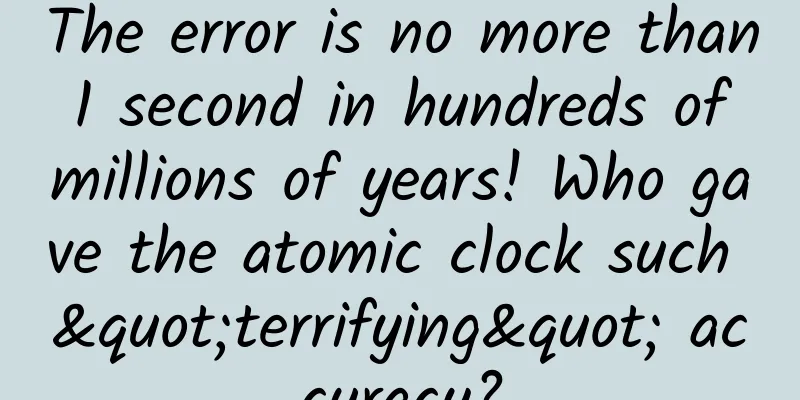The error is no more than 1 second in hundreds of millions of years! Who gave the atomic clock such "terrifying" accuracy?

|
What is the principle of atomic clocks? How do they work? This is a question that we often encounter when watching the news, and this year, there happened to be a lot of news about new progress made in various atomic clocks in my country. For example: Currently, the second-level stability of commercial rubidium atomic clocks is usually at the E-11 to E-12 level. In January this year, according to media reports, the new rubidium atomic clock developed in my country has for the first time reached the E-14 level, or one trillionth, in terms of the core indicator of second-level frequency stability. Also in January this year, according to media reports, a Chinese research team successfully developed a 10,000-second stability and uncertainty better than A strontium atomic optical lattice clock (equivalent to an error of no more than 1 second in billions of years). China's Micius quantum science experimental satellite was launched in 2016. The medium- and high-orbit quantum satellites that are being developed and will be launched in the future will be equipped with atomic clocks with higher precision. (Image copyrighted by the library; reprinting and use may cause copyright disputes) 01 How to define the accuracy of a clock? Before talking about atomic clocks, let's think about this question: How to define the accuracy of a clock? The answer is: The finer the time is divided by this kind of clock, the more accurate the time obtained will be. For example: If the earth's revolution is regarded as a clock, its accuracy is "year"; Similarly, if the moon's rotation around the earth is used as a clock, its accuracy is "month"; If the rotation of the earth is regarded as a clock, its accuracy is "day". Obviously, you will admit that: The accuracy of the "Earth Rotation Clock" is much higher than that of the "Earth Revolution Clock" because the former can divide time into days, while the latter can only divide time into years. 02 The frequency of the clock is the key factor The frequency of the "Earth Revolution Clock" is once a year, while the frequency of the "Earth Rotation Clock" is about 365 times a year. The latter is more accurate. The above facts tell us that as long as we can find "something" with higher frequency and better repeatability, and then use this "thing" as a clock, it will be fine. So, what things change most frequently? In 1880, scientists discovered that quartz has a piezoelectric effect - applying pressure to a piece of quartz material will generate an electric current. So what happens in reverse? The reverse is also true: if an electric field is applied to a piece of quartz, it will vibrate. This is the "inverse piezoelectric effect." So, what is the vibration frequency of quartz under the influence of electric field? The answer is uncertain, because the frequency of quartz varies depending on the cut shape. However, one of the most classic cutting shapes corresponds to a frequency of 32768 Hz, which means it vibrates 32768 times in 1 second. Therefore, as long as we make sure the "cut shape" is the same, we can get a fixed frequency. So, we got the quartz clock. Quartz clock, image from Wikipedia. After the advent of the quartz clock, human beings' ability to subdivide time has taken a big step forward. One second is divided into 32,768 equal parts, which is many times more accurate than the "Earth Rotation Clock". In order to further climb the "peak" of precision, scientists have turned their attention to the inside of the atom! 03 Quantum mechanics to the rescue According to the traditional image, the movement of electrons outside the nucleus is on an "orbit". However, unlike the macroscopic world, electrons do not always move on only one orbit. Sometimes they "run" from one orbit to another. In quantum mechanics, this is called a "transition." Atoms have different "energy levels", which are determined by the different orbits of the electrons outside the nucleus. That is to say, when the electron is in one orbit, the atom is at one energy level, and when the electron jumps to another orbit, the atom is at another energy level. There will be an energy difference between the two energy levels of an atom. The energy difference here is constant, so we use "△W" to replace it. When the electrons outside the nucleus absorb the △W energy from the outside, they will jump to another orbit. Conversely, if the electron returns from this orbit to its original orbit, it will "spit out" the △W energy originally absorbed. The △W energy here is actually electromagnetic waves, and the energy of electromagnetic waves is different and their frequencies are also different. Another thing is that different atoms have different energy differences between their energy levels. And the energy difference is actually an electromagnetic wave, so we can detect the specific electromagnetic waves emitted by atoms to identify different atoms. Finally, when an electron transitions between two different energy levels, absorbing or radiating "a portion" of the same energy difference, this energy difference is less likely to change due to changes in the environment than other things. It can be said that when the environmental conditions such as temperature, humidity, and magnetic field are basically fixed, the energy difference is constant. Whether it is 1 billion years or 100 billion years, it will not change because it is an inherent property of the atom itself. There are many isotopes of cesium, such as cesium-133 and cesium-137. Here, the protagonist we are going to talk about is cesium-133. High-purity cesium-133 is stored in argon gas. Image from Wikipedia. As the 55th element, cesium has 55 electrons outside its nucleus. So it is not difficult to understand that the energy levels of cesium atoms are diverse and complex. However, this does not matter, because the cesium atomic clock uses the outermost electron, and the outermost electron has only one electron, running in a relatively independent orbit. Its energy level transition is the easiest to identify. Cesium atom electron layer (copyright image from the library, reprinting may cause copyright disputes) So, what is the frequency of the electromagnetic waves absorbed or emitted by the energy level transition of the outermost electron of the cesium atom? The answer is 9192631770 Hz. A quartz clock can divide 1 second into 32768 parts, but this level of time accuracy is still not enough to be used in satellite positioning. However, once we are able to divide 1 second into 9,192,631,770 equal parts, or about 9.2 billion, we have enough accuracy. 04 The general operating principle of atomic clocks To simplify it, it looks like this: Step 1: Prepare cesium atoms We first need to create a large group of cesium atoms with the same energy level. This is relatively easy to do and is usually achieved by heating cesium metal and evaporating it into a gas. Step 2: Vacuum tube closed transmission This large group of cesium atoms is guided through a vacuum tube that is sealed to prevent the atoms from interacting with the outside environment and affecting their energy levels. Step 3: Microwave Radiation In the tube, scientists irradiate the atoms with microwaves (a type of electromagnetic wave) of a specific frequency. Only when the frequency of the microwaves precisely matches the hyperfine structure transition frequency of cesium atoms, which is about 9,192,631,770 hertz, will the cesium atoms absorb these microwaves and transition from one hyperfine energy level to another. Step 4: Detection signal When cesium atoms absorb microwaves and complete the transition, they will return to their original energy level at a certain point and re-release the energy previously absorbed, also in the form of electromagnetic waves. This released electromagnetic wave signal can be detected, thus confirming that the microwave frequency previously emitted was indeed 9192631770 Hz. Step 5: Precise frequency control By continuously adjusting the frequency of microwaves and detecting whether cesium atoms undergo transitions, humans can determine and control the microwave frequency very accurately. To sum up, you can think that the principle of atomic clock is actually a "double confirmation" process, namely: Although we are trying to transmit electromagnetic waves with a frequency of 9192631770 Hz, how can you be sure that the electromagnetic waves you transmit are of this frequency? We don't know. This requires a confirmation process. Therefore, we could only keep debugging. However, at some point, when we received a strong signal emitted by a large number of cesium atoms after the transition, we confirmed the fact: The frequency of the electromagnetic waves we emit is really 9192631770 Hz. This frequency corresponds to 9192631770 cycles in 1 second. The cycles are counted by an electronic counter. Every time 9192631770 cycles occur, the second will jump. Every time the electronic counter counts 4596315885 times, it means that 0.5 seconds has passed. The above is the basic principle of cesium atomic clock. 05Explain with "skipping rope" In fact, we can also use "skipping rope" to understand the principles of atomic clocks. In rope skipping, two people hold the two ends of a rope and swing the rope in circles at a certain frequency. If the frequency is one circle per second, the person skipping the rope must also jump at this frequency, that is, once per second, otherwise he will fail soon. If the frequency of waving the rope is 9192631770 Hz, then the person jumping rope must also jump 9192631770 times in 1 second, so that they are in sync. If there are really some people in the world who can live without food or water and can keep their heart beating 9192631770 times per second under certain conditions, then we don't have to go far to look for cesium atoms to help us, we can just use these people. Unfortunately, there is no one on earth, and no man-made object, that can beat at such a constant cycle under certain conditions. Therefore, the cesium atoms here are actually equivalent to those "rope skippers" who can jump at a constant period under specific conditions. The electromagnetic waves we send to the cesium atoms are actually equivalent to the two people swinging the rope. If the two move in sync, we can conclude that the frequency of artificially swinging the rope is 9192631770 times in 1 second. We can't conveniently count those who jump rope, but it doesn't matter, we can just use an advanced "electronic counter" to count the number of times the rope is swung. In summary, we can also say that: Using an extremely advanced "electronic counter" based on frequency division technology and high-speed counter chips, we can count more than 10 billion times in 1 second. However, we cannot use it as a clock. Because although you counted 92 billion times this time, you may have completed the counting in 10.1 seconds. Next time, you counted 92 billion times again, and you may have completed it in 9.9999 seconds. So, the big question is, how do you make sure that each successive count counts the same number of times in the same amount of time? You can't be sure, because you don't have a constant reference. So, you can use the fixed properties of cesium atoms as a reference. Author: Hanmu Diaomeng, a popular science writer and winner of the "National Excellent Popular Science Work Award" from the Ministry of Science and Technology Reviewer: Liu Ya, Researcher at the National Time Service Center of the Chinese Academy of Sciences Produced by: Science Popularization China Produced by: China Science and Technology Press Co., Ltd., China Science and Technology Publishing House (Beijing) Digital Media Co., Ltd. |
<<: Today, the geomagnetic storm red alert is in effect! Will it keep us awake?
>>: Can drinking "magic liquid" before a physical test really improve your physical fitness?
Recommend
Why is it always China Telecom that leaks information?
Around the 22nd of last month, an internal speech...
Detailed explanation of JSPatch implementation principle: Let JS call/replace any OC method
JSPatch is a small-sized JavaScript library that ...
AE animation tutorial video "The Secret of Keyframes"
Training course content: It covers every aspect o...
Electricity is cheaper than oil. Double glory in the ocean. BYD Song PLUS Glory Edition and Seal DM-i Glory Edition are launched
On February 29, BYD Song PLUS Honor Edition and H...
New way of playing in the post-user operation traffic era: private domain traffic!
Introduction: The inducing sharing in Moments is ...
How many sparks will occur when HTML5 meets Native?
A few days ago, there was a piece of news that at...
Let's go! See China's five major national parks
October 12, 2021 At the Conference of the Parties...
OTT has nearly 400 million users, forming a traffic gold mine. Can large-screen advertising become the next outlet for the living room economy?
With the rapid development of smart TVs in recent...
Chronic patients don't have to worry about winter! 6 "magic weapons" to warm the body and heart, family members must read
1. Dress like an onion, wrap yourself tightly lay...
30 important time points you must know to help you understand China's lunar exploration project!
15 years ago today, the first satellite of China&...
After viewing more than 100,000 information flow ads, I summarized these 4 optimization directions!
After reading this article, you will get the foll...
Question: Who stole my cell phone signal?
As a communications engineer, I am often asked th...
How to cleverly use celebrities to achieve a cold start for a product?
For those who work in operations , the word they ...
What is the reason for the instability of Beijing website ranking marketing?
Many webmasters or network operators have to do t...









